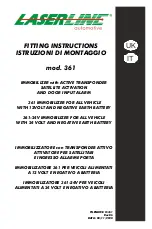
Operating Relative Humidity
10-85% RH (non-condensing)
Alarm Loudness
≥ 85 dB at 3.28 ft (1 m)
Storage and Transport Conditions
-4 to 140°F (-20 to 60°C), 5% to 95% RH (non-condensing)
Silence Duration
About 9 minutes
Operating Frequency
915 MHz
Maximum Number of Interconnected
Units
24 wireless units (only compatible with X-Sense wireless
alarms)
Transmission Range
Over 820 ft (250 m) in open air
NOTES
1.
Battery life is calculated on the current ratings in the standby mode with weekly testings. If its operation
mode changes to an alarming condition, the battery life will be decreased accordingly.
2.
The CO alarm functions between 40 and 100°F (4.4 and 37.8°C). Prolonged exposure to temperatures outside
of this range can reduce battery life and affect accuracy. We do not recommend operating the device outside
of this range.
What to Do When the CO Alarm Sounds
1.
Call emergency services as soon as possible.
2.
Immediately move outside and make sure that everyone inside the house has evacuated the area or has access to
fresh air. Do not re-enter the house until it has been aired out and your alarm remains under normal condition. If it
is not possible to move outside, stay close to an open door/window until emergency service responders arrive.
3.
After following steps 1–2 above, if your alarm reactivates within a 24 hour period, repeat steps 1–2 and call a
qualified appliance technician to investigate sources of CO from fuel-burning equipment and appliances, and
inspect for proper operation of this equipment.
4.
If problems are identified during this inspection, have the equipment serviced immediately. Note any combustion
equipment that has not been inspected by the technician and consult the manufacturer’s instructions, or contact the
manufacturers directly for more information about CO safety and this equipment. Make sure that motor vehicles are
not, and have not been, operating in an attached garage or adjacent to the residence.
Maintenance
To keep your alarm in good working order, you should adhere to the following steps.
1.
Test the alarm once a week by pressing the TEST/HUSH button.
2.
Vacuum the alarm cover once a month to remove any accumulated dust.




































